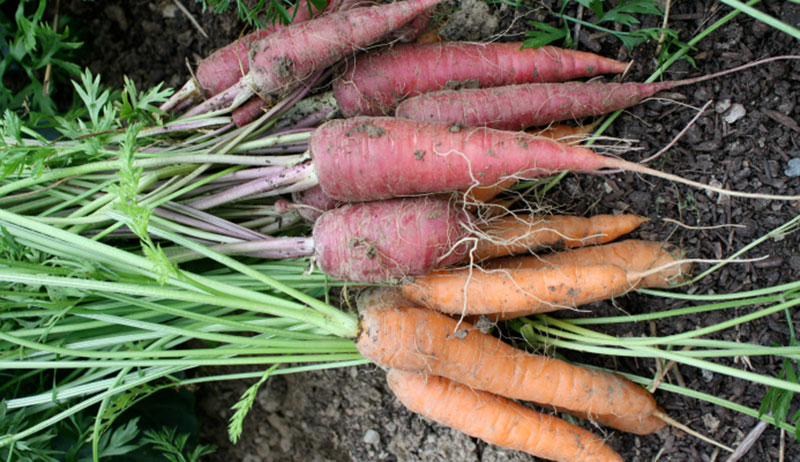
The best soil for carrots is something you can prepare yourself with a little knowledge and soil preparation.
While straight carrots might not taste any better than crooked or forked ones, they sure are easier to harvest and handle in the kitchen—not to mention a better sell at market. And no farmer enjoys tossing pest-damaged carrots onto the compost pile. While less-than-perfect carrots aren’t the end of the world, growing straight, pest-free roots isn’t as difficult as you might think. Here are six soil-management tasks to ensure your best carrot crop yet. If you’re looking for carrot seeds, try Jung Seeds.
1. Make a Cozy Bed
Depending on the variety, carrots can plunge 7 or 8 inches into the soil. This means that for straight, uniform roots, a deep seed bed is an absolute necessity. The best soil for carrots should be loose, friable soil tilled to a depth of 10 to 12 inches, and because they’ll fork when they hit an obstacle, removing rocks and debris from the soil is a must.
2. Fertilize with Phosphorus
Growing carrots, like most root crops, require a good amount of phosphorus to perform their best. Because carrots have a single, thick taproot rather than many small fibrous roots, the zone from which they can absorb phosphorus is relatively small. (Believe it or not, the root-surface area of even a large carrot is nowhere near as large as the root-surface area of a plant with more fibrous roots, like a tomato or pepper.)
Unlike many other nutrients, phosphorus isn’t absorbed by a plant as it draws in water. Instead, it’s absorbed via diffusion, naturally moving from an area of higher concentration (the soil) to one of lower concentration (inside the root). The soil area from which phosphorous can be absorbed is limited to a very small space around the root itself. If a soil test indicates a need for this essential nutrient, adding an organic phosphorus fertilizer, like bonemeal or rock phosphate, to the planting area a few weeks before seeding will ensure the growing roots have ready access to this nutrient right where they need it.
3. The Best Soil for Carrots Should Have a Balanced pH
Like most other vegetable crops, carrots grow best when the soil pH is between 6.2 and 6.8. Use a soil test to determine the pH of your garden’s soil, and then add the recommended amount of lime to raise it if the results show a pH that is too low (acidic) for optimum carrot growth. If the pH comes back too high (alkaline), you’ll need to apply the suggested amount of elemental sulfur to drop the pH to the desired number. Keep in mind, though, that a pH test should be performed every two or three years as the effects of lime or sulfur are eventually negated and the soil pH will return to its native range.
4. Water It Just Right
Keep the soil well-watered, but don’t overdo it. Once your carrots are up and growing, they’ll require a good amount of water to reach their full potential. Carrots are not drought-tolerant and will sometimes fork, gnarl or turn pithy if the soil gets too dry. On the other hand, if the soil gets too wet in the later stages of root development, carrots will split open and might show signs of rot. Irrigate at ground level, if possible, as wet foliage promotes fungal diseases, such as leaf blight, cankers, crown rot, powdery mildew and carrot rust. If overhead watering is necessary, water only in the morning to allow enough time for the foliage to dry before nightfall.
5. Keep Carrots Covered
As the carrots grow, their shoulders may might up out of the ground. If this happens, mound soil or mulch up over the exposed crowns mid-season. Exposure to sunlight can cause the shoulders to turn green and bitter.
6. Control Soil Pests
Carrot root maggots (the larvae of the carrot root fly) and wireworms (the larvae of click beetles) can become problematic in the carrot patch, causing tunnels and pitting throughout the roots. Thankfully, they are easily—and organically—prevented and treated by applying beneficial nematodes to the soil around your carrot crop. Beneficial nematodes are microscopic, worm-like organisms that seek out and attack ground-dwelling pests. Mixed with water and applied via spay or sprinkle on a cloudy or rainy day, Steinernema carpocapsae actively move through the soil, find the pests and eliminate them. Nematodes can be applied to the soil at the start of the gardening season before seeds are even planted (as long as the soil temperature is a minimum of 42 degrees F) or at any time throughout the growing season.’
This article about the best soil for carrots was written for Hobby Farms magazine. Click here to subscribe.




